#1888 - oil on canvas. — Sir Lawrence Alma-Tadema
Text
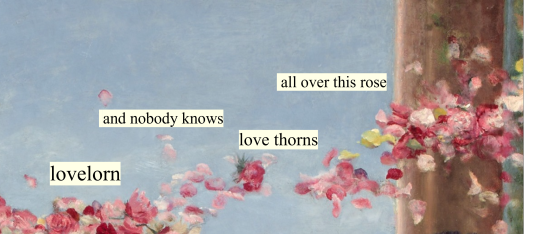
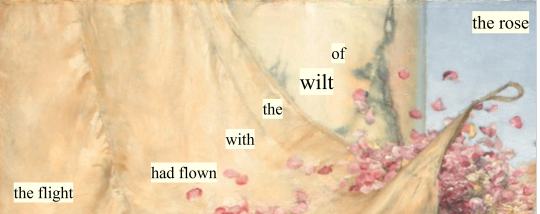
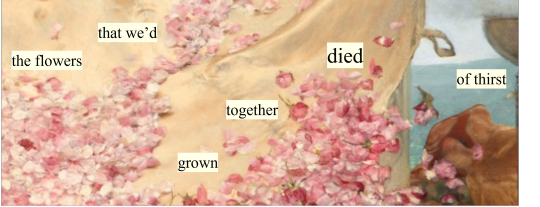
slut! // is it over now? // clean
#my edit#taylor swift#1989#1989 taylor's version#1989 tv#is it over now?#original painter: Sir Lawrence Alma-Tadema#clean#haylor#tswiftlyrics#lyric edit#taylor swift lyrics#tswiftedit#harry styles#typography#lyric parallels#taylor swift lyric parallels#1989 lyric parallels#The Roses of Heliogabalus#1888 - oil on canvas. — Sir Lawrence Alma-Tadema#Sir Lawrence Alma-Tadema#lawrence alma-tadema#art#paintings#sir lawrence alma-tadema#art details#classical art#oil painting#classic art#oil on canvas
580 notes
·
View notes
Photo

Detail of The Roses of Heliogabalus (1888)
by Sir Lawrence Alma-Tadema
#The Roses of Heliogabalus#1888#1800s#Elagabalus#Sir Lawrence Alma-Tadema#dutch#roman#banquet#roses#rose#flowers#painting#paint#art#illustration#rose petals#oil on canvas#Heliogabalus#Lawrence Alma-Tadema#HQ#dreamadot#dreamdot#flower#color#Romanticism
60 notes
·
View notes
Photo

I’m in the garden.
#i'm in the garden#the roses of heliogabalus#detail#oil on canvas#alma tadema#sir lawrence alma-tadema#1888#beauty
5 notes
·
View notes
Text




Details of The Roses of Heliogabalus by Sir Lawrence Alma-Tadema (1888). Oil on canvas.
280 notes
·
View notes
Photo

The Favourite Poet, 1888, Lawrence Alma-Tadema
Medium: oil,canvas
https://www.wikiart.org/en/sir-lawrence-alma-tadema/the-favourite-poet-1888
97 notes
·
View notes
Text
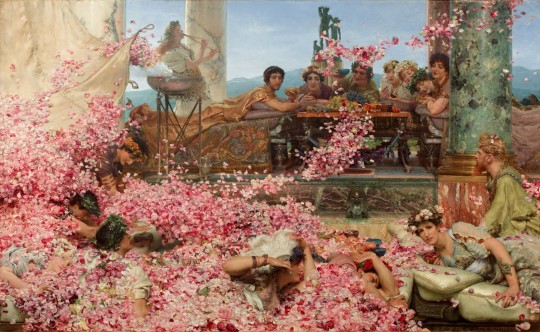


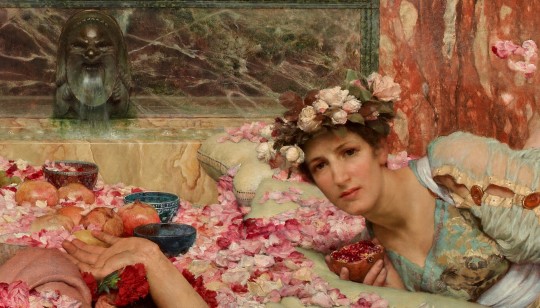
“The Roses of Heliogabalus (1888), oil on canvas, 132.1 × 213.7 cm, private collection. ”
Sir Lawrence Alma-Tadema (8 January 1836 – 25 June 1912) was a Dutch painter of special British denizenship.
50 notes
·
View notes
Photo

Sir Lawrence Alma-Tadema (1836–1912) The Roses of Heliogabalus (Detail) Oil on canvas, 1888
18 notes
·
View notes
Text
Alighieri Dante (c. 1265–1321) La Divina Commedia Inferno Canto V. I. 1-15 Minos who judges the second circumference, 7-9, 9. E quel conoscitor de le peccata (Then, those connoisseur of the day of the peccable), Rembrandt van Rijn (Dutch, 1606-1669), Simeon with the Christ Child in the Temple, 1669, Nationalmuseum Stockholm., William Holman Hunt OM (English, 1827–1910), The Finding of the Saviour in the Temple, 1860, Birmingham Museum & Art Gallery., John Singer Sargent (American,1856–1925), Carnation, Lily, Lily, Rose, 1885–6, Tate., Sir Lawrence Alma-Tadema, OM, RA (Dutch, 1836–1912), The Roses of Heliogabalus, 1888, John William Waterhouse RA (English, 1849–1917), The Lady of Shalott, 1888, Tate Britain., Sir Lawrence Alma-Tadema, Silver Favourites, 1903, Manchester Art Gallery., William Holman Hunt, The Lady of Shalott, c. 1888–1905, Wadsworth Atheneum, Hartford.
Alighieri Dante (c. 1265–1321) La Divina Commedia Inferno Canto V. I. 1-15 Minos who judges the second circumference, 7-9, 9. E quel conoscitor de le peccata (Then, those connoisseur of the day of the peccable), Rembrandt van Rijn (Dutch, 1606-1669), Simeon with the Christ Child in the Temple, 1669, Nationalmuseum Stockholm., William Holman Hunt OM (English, 1827–1910), The Finding of the Saviour in the Temple, 1860, Birmingham Museum & Art Gallery., John Singer Sargent (American,1856–1925), Carnation, Lily, Lily, Rose, 1885–6, Tate., Sir Lawrence Alma-Tadema, OM, RA (Dutch, 1836–1912), The Roses of Heliogabalus, 1888, John William Waterhouse RA (English, 1849–1917), The Lady of Shalott, 1888, Tate Britain., Sir Lawrence Alma-Tadema, Silver Favourites, 1903, Manchester Art Gallery., William Holman Hunt, The Lady of Shalott, c. 1888–1905, Wadsworth Atheneum, Hartford.
https://blog.naver.com/artnouveau19/222651187290
Alighieri Dante (c. 1265–1321)
La Divina Commedia
Inferno
Canto V.
I. 1-15
Minos who judges the second circumference
Dico che quando l’anima mal nata (I say that when the spirit of the sickness born)
Li vien dinanzi, tutta si confessa; (Arrive at the front of them, it confesses everything.)
E quel conoscitor de le peccata (Then, those connoisseur of the day of the peccable)
Rembrandt van Rijn (Dutch, 1606-1669), Simeon with the Christ Child in the Temple, Oil on tablecloth (olija pa duk), 1669, 98.5x79.5cm, Nationalmuseum Stockholm.
http://collection.nationalmuseum.se/eMP/eMuseumPlus?service=ExternalInterface&module=collection&objectId=21617&viewType=detailView
https://en.wikipedia.org/wiki/Simeon_in_the_Temple
William Holman Hunt OM (2 April 1827 – 7 September 1910) was an English painter and one of the founders of the Pre-Raphaelite Brotherhood. His paintings were notable for their great attention to detail, vivid colour, and elaborate symbolism. These features were influenced by the writings of John Ruskin and Thomas Carlyle, according to whom the world itself should be read as a system of visual signs. For Hunt it was the duty of the artist to reveal the correspondence between sign and fact. Of all the members of the Pre-Raphaelite Brotherhood, Hunt remained most true to their ideals throughout his career. He was always keen to maximise the popular appeal and public visibility of his works.[
https://en.wikipedia.org/wiki/William_Holman_Hunt
William Holman Hunt OM (English, 1827–1910), The Finding of the Saviour in the Temple, 1860, Oil on canvas, 141.0×85.7 cm, Birmingham Museum & Art Gallery, Birmingham.
https://en.wikipedia.org/wiki/The_Finding_of_the_Saviour_in_the_Temple
The Finding of the Saviour in the Temple (1854–1860) is a painting by William Holman Hunt intended as an ethnographically accurate version of the subject traditionally known as "Christ Among the Doctors", an illustration of the child Jesus debating the interpretation of the scripture with learned rabbis. The passage illustrated is from the Gospel of Luke, 2:41, which states:
Every year his parents went to Jerusalem for the Feast of the Passover. When he was twelve years old, they went up to the Feast, according to the custom. After the Feast was over, while his parents were returning home, the boy Jesus stayed behind in Jerusalem, but they were unaware of it. Thinking he was in their company, they traveled on for a day. Then they began looking for him among their relatives and friends. When they did not find him, they went back to Jerusalem to look for him. After three days they found him in the temple courts, sitting among the teachers, listening to them and asking them questions. Everyone who heard him was amazed at his understanding and his answers. When his parents saw him, they were astonished. His mother said to him, "Son, why have you treated us like this? Your father and I have been anxiously searching for you." "Why were you searching for me?" he asked. "Didn't you know I had to be in my Father's house?" But they did not understand what he was saying to them.
https://en.wikipedia.org/wiki/The_Finding_of_the_Saviour_in_the_Temple
John William Waterhouse RA (6 April 1849 – 10 February 1917) was an English painter known for working first in the Academic style and for then embracing the Pre-Raphaelite Brotherhood's style and subject matter. His artworks were known for their depictions of women from both ancient Greek mythology and Arthurian legend.
https://en.wikipedia.org/wiki/John_William_Waterhouse
John William Waterhouse RA (English, 1849–1917), A Sick Child brought into the Temple of Aesculapius, 1877
https://en.wikipedia.org/wiki/John_William_Waterhouse#/media/File:TempleofAesculapiusWaterhouse.jpg
John Singer Sargent (American, Florence 1856–London 1925), Carnation, Lily, Lily, Rose, 1885–6, Oil paint on canvas, Support: 1740×1537 mm, frame: 2185×1970×130 mm, Tate.
https://www.tate.org.uk/art/artworks/sargent-carnation-lily-lily-rose-n01615
John Singer Sargent (/ˈsɑːrdʒənt/; January 12, 1856 – April 14, 1925)[1] was an American expatriate artist, considered the "leading portrait painter of his generation" for his evocations of Edwardian-era luxury.[2][3] He created roughly 900 oil paintings and more than 2,000 watercolors, as well as countless sketches and charcoal drawings. His oeuvre documents worldwide travel, from Venice to the Tyrol, Corfu, the Middle East, Montana, Maine, and Florida.
https://en.wikipedia.org/wiki/John_Singer_Sargent
Sir Lawrence Alma-Tadema, OM, RA (Dutch, Dronryp, Netherlands 1836–Wiesbaden, German Empire 1912)
Sir Lawrence Alma-Tadema, OM, RA (/ˈælmə ˈtædeɪmə/;[1] born Lourens Alma Tadema Dutch pronunciation: [ˈlʌurəns ˈɑlmaː ˈtaːdəˌmaː]; 8 January 1836 – 25 June 1912) was a Dutch painter of special British denizenship. Born in Dronryp, the Netherlands, and trained at the Royal Academy of Antwerp, Belgium, he settled in London, England in 1870 and spent the rest of his life there. A classical-subject painter, he became famous for his depictions of the luxury and decadence of the Roman Empire, with languorous figures set in fabulous marbled interiors or against a backdrop of dazzling blue Mediterranean Sea and sky. Alma-Tadema was considered one of the most popular Victorian painters. Though admired during his lifetime for his draftsmanship and depictions of Classical antiquity, his work fell into disrepute after his death, and only since the 1960s has it been re-evaluated for its importance within nineteenth-century British art.
https://en.wikipedia.org/wiki/Lawrence_Alma-Tadema
Sir Lawrence Alma-Tadema, OM, RA (Dutch, 1836–1912), The Roses of Heliogabalus, 1888, oil on canvas, 132.1×213.7 cm, private collection.
https://en.wikipedia.org/wiki/The_Roses_of_Heliogabalus
John William Waterhouse RA (English, 1849–1917), The Lady of Shalott, 1888, Oil on canvas, 183×230 cm (72×91 in), Tate Britain, London.
https://www.tate.org.uk/art/artworks/waterhouse-the-lady-of-shalott-n01543
The Lady of Shalott is a painting of 1888 by the English painter John William Waterhouse. It is a representation of the ending of Alfred, Lord Tennyson's 1832 poem of the same name.[1] Waterhouse painted three versions of this character, in 1888, 1894 and 1915. It is one of his most famous works, which adopted much of the style of the Pre-Raphaelite Brotherhood, though Waterhouse was painting several decades after the Brotherhood split up during his early childhood. The Lady of Shalott was donated to the public by Sir Henry Tate in 1894 and is usually on display in Tate Britain, London, in room 1840.
https://en.wikipedia.org/wiki/The_Lady_of_Shalott_(painting)
Sir Lawrence Alma-Tadema, OM, RA (Dutch, 1836–1912), A Dedication to Bacchus, 1889, Kunsthalle Hamburg.
https://commons.wikimedia.org/wiki/File:A_Dedication_to_Bacchus.jpg
Sir Lawrence Alma-Tadema, OM, RA (Dutch, 1836–1912), Unconscious Rivals, 1893, oil on panel, 45×63 cm, Bristol City Museum and Art Gallery.
https://en.wikipedia.org/wiki/Lawrence_Alma-Tadema#/media/File:Alma-Tadema_Unconscious_Rivals_1893.jpg
Sir Lawrence Alma-Tadema, OM, RA (Dutch, 1836–1912), Silver Favourites, 1903, oil on wood, 69.1×42.2 cm, Manchester Art Gallery.
https://artuk.org/discover/artworks/silver-favourites-204369
William Holman Hunt OM (English, 1827–1910), The Lady of Shalott, c. 1888–1905, Wadsworth Atheneum, Hartford.
https://commons.wikimedia.org/wiki/File:The_Lady_of_Shalott_by_William_Holman_Hunt,_c._1890-1905,_oil_on_canvas_-_Wadsworth_Atheneum_-_Hartford,_CT_-_DSC05541.jpg
https://www.ngv.vic.gov.au/essay/the-breaking-of-the-web-william-holman-hunts-two-early-versions-of-the-lady-of-shallot/
The Lady of Shalott is an oil painting by William Holman Hunt, made c. 1888-1905, and depicting a scene from Tennyson's 1833 poem, "The Lady of Shalott". The painting is held by the Wadsworth Atheneum, in Hartford, Connecticut. A smaller version is held by the Manchester Art Gallery.
https://en.wikipedia.org/wiki/The_Lady_of_Shalott_(William_Holman_Hunt)
0 notes
Photo

Sir. Lawrence Alma-Tadema - The Roses of Heliogabalus
1888 / oil on canvas / 131,8 cm × 213,4 cm / private collection
#alma tadema#alma-tadema#lawrence alma-tadema#the roses of heliogabalus#1888#1880s#1800#art pompier#romanticism#romanticist#private collection#art#art lover
3 notes
·
View notes
Text
Despite my continuing to wrack the old brains, I still have not identified the floral feast from an also as yet unremembered childhood tale. Today’s post is nonetheless still redolent of flowers, albeit flowers put to a deadly purpose. May I present Sir Lawrence Alma Tadema‘s The Roses of Heliogabalus?

The Roses of Heliogabalus, 1888 (oil on canvas), Alma-Tadema, Lawrence (1836-1912) / Private Collection. Source: Wikimedia Commons.
Heliogabalus is the young man wearing a golden cloak, lying on a couch before a banquet, with a musician playing behind him and his guests. Alma-Tadema has depicted a murderous day in the life of this Roman Emperor, as he watches some of his courtiers effectively suffocate under the weight and perfume of the rose petals he has ordered dropped on them via a collapsible ceiling. I really don’t know much else about His Imperial Floral Killer-ness, but Martijn Icks’s book The Crimes of Elagabalus: The Life and Legacy of Rome’s Decadent Boy Emperor got a good review on the Times Higher Education website. The food, the banquet, although it does look delicious, is not the focus of the painting, but when you understand what is happening while the Emperor eats, it becomes a sinister meal – who could sit and eat so blithely as people die in front of them?
It was only while looking for more information about the painting that I discovered that while Alma-Tadema showed us roses, Heliogabalus used violets:
In a banqueting-room with a reversible
ceiling he once overwhelmed his parasites with violets
and other flowers, 1 so that some of them were actually
smothered to death, being unable to crawl out to the
top.
Source: The Scriptores historiae augustae with an English translation (Cambridge: Harvard University Press, 1921-32). Via Archive.org
It’s difficult to see a rose as a killer, but even more so a violet. Roses can be much larger, and their perfume much stronger. A violet is small and delicate. To make my case in pictures better than I can in words (and to let me sleep!), here are two pictures from J. J. Grandville’s Les Fleurs Animées (Paris: Garnier Freres, 1867):
Source: J. J. Grandville’s Les Fleurs Animées (Paris: Garnier Freres, 1867), at Archive.org
The violets are sitting quietly in the shade, almost hidden from view – you could never see them as deadly. The rose, on the right above, is tall and proud, dominating the picture. She could be carrying a trident made of thorns, and has kneeling at her feet creatures whose shells suggest that they could easily be an army. She does look as though she could kill. I don’t know what Alma-Tadema’s reason was for using roses instead; the above is my conjecture about the nature of the flowers when used to kill. If anybody can suggest some further reading on The Roses of Heliogabalus, I would be very grateful.
I will end by saying that one of the best discussions of The Roses… that I’ve heard was in a presentation by my former colleague Dr Christina Bradstreet, which I wrote about in a blog post a few years back, in 2013. I really am looking forward to seeing more of Christina’s thoughts on perfume in art when her book on the subject comes out (no date at present that I know of), and in the meantime, her PhD thesis from the Courtauld Institute – Scented visions: the nineteenth-century olfactory imagination is available to download for free from the British Library’s EThOS collection of doctoral theses. If you could smell the roses as you looked at the painting above, I’m confident that you will find the thesis an excellent read.
December 5: A deadly feast Despite my continuing to wrack the old brains, I still have not identified the floral feast from an also as yet unremembered childhood tale.
#Christmas Feasts#J. J. Grandville#Lawrence Alma Tadema#Les fleurs animées#The Roses of Heliogabalus
0 notes
Photo

The Roses of Heliogabalus, 1888, Lawrence Alma-Tadema
Medium: oil,canvas
https://www.wikiart.org/en/sir-lawrence-alma-tadema/the-roses-of-heliogabalus-1888
34 notes
·
View notes
Photo
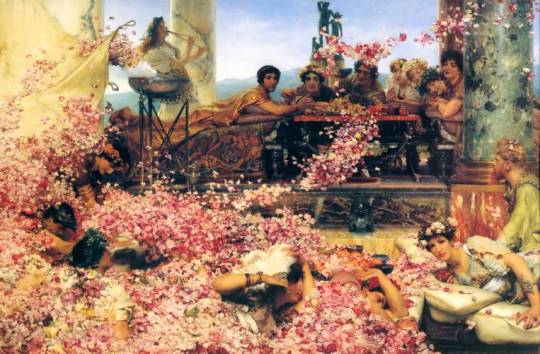
The Roses of Heliogabalus, 1888, Lawrence Alma-Tadema
Medium: oil,canvas
https://www.wikiart.org/en/sir-lawrence-alma-tadema/the-roses-of-heliogabalus-1888
86 notes
·
View notes
Photo

The Favourite Poet, 1888, Lawrence Alma-Tadema
Medium: oil,canvas
https://www.wikiart.org/en/sir-lawrence-alma-tadema/the-favourite-poet-1888
12 notes
·
View notes
Photo

The Favourite Poet, 1888, Lawrence Alma-Tadema
Medium: oil,canvas
https://www.wikiart.org/en/sir-lawrence-alma-tadema/the-favourite-poet-1888
15 notes
·
View notes
Photo
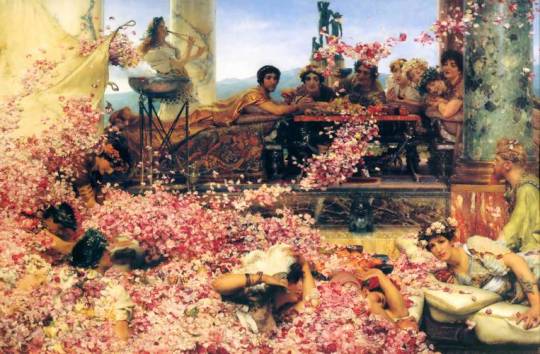
The Roses of Heliogabalus, 1888, Lawrence Alma-Tadema
Medium: oil,canvas
https://www.wikiart.org/en/sir-lawrence-alma-tadema/the-roses-of-heliogabalus-1888
119 notes
·
View notes